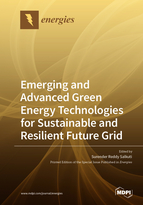Emerging and Advanced Green Energy Technologies for Sustainable and Resilient Future Grid
A special issue of Energies (ISSN 1996-1073). This special issue belongs to the section "A1: Smart Grids and Microgrids".
Deadline for manuscript submissions: closed (31 July 2022) | Viewed by 52862
Special Issue Editor
Interests: market clearing including renewable energy sources; demand response; smart grid development with integration of wind and solar PV energy sources; artificial intelligence applications in power systems; power system analysis and optimization; energy and environmental economics; multi-objective optimization
Special Issues, Collections and Topics in MDPI journals
Special Issue Information
Dear Colleagues,
The Guest Editor is inviting submissions to a Special Issue of Energies on the subject area of “Emerging and Advanced Green Energy Technologies for Sustainable and Resilient Future Grid”.
Future grid is the next generation of the electrical grid, which will enable smart integration of conventional, renewable, and distributed power generation, energy storage, transmission and distribution, and demand management. Renewable energy is crucial in transitioning to a less carbon-intensive economy and a more sustainable energy system. The high penetration and uncertain power outputs of renewable energy poses a great challenge to the stable operation of energy systems. The deployment of the smart grid is revolutionary, and also imperative around the world. It involves and deals with multidisciplinary fields such as energy sources, control systems, communications, computational, generation, transmission, distribution, customer, operations, markets, and service provider. Smart grids are emerging in both developed and developing countries, with the aim of achieving a reliable and secure electricity supply. Smart grids will eventually need standards, policy, and a regulatory framework for successful implementation.
The purpose of this Special Issue is to address the emerging and advanced green energy technologies for a sustainable and resilient future grid, and to provide a platform to enhance interdisciplinary research and share the most recent ideas. The following areas are deemed as high priority areas in smart grid technologies: information and communication technology integration, transmission enhancement applications, distribution and management, advanced metering infrastructure, charging infrastructure, sharing of energy storage, demand flexibility to the grid, and trading of renewable energy.
The Special Issue invites original contributions on, but not limited to, the themes and topics in following areas of research:
- Renewable power and clean energy technologies;
- Design and operation of sustainable energy systems;
- Smart grid architectures and cyber and physical security;
- Smart grid and green energy integration;
- Operation and control of renewable energy sources;
- Smart grid and smart cities modeling;
- Forecasting techniques for renewable energy sources and loads;
- Electric vehicle systems for smart grid;
- Distributed generation and distributed storage;
- Agent-based smart grid simulation;
- Decision support approaches for smart grids;
- Electricity market modeling and simulation for the integration of renewable sources;
- Intelligent approaches for smart grid management;
- Multi-agent applications for smart grids;
- Smart grid energy management system;
- Computational intelligence technologies for sustainable energy;
- Machine learning, IoT, and big data applications for energy systems;
- Demand side management.
Prof. Dr. Surender Reddy Salkuti
Guest Editor
Manuscript Submission Information
Manuscripts should be submitted online at www.mdpi.com by registering and logging in to this website. Once you are registered, click here to go to the submission form. Manuscripts can be submitted until the deadline. All submissions that pass pre-check are peer-reviewed. Accepted papers will be published continuously in the journal (as soon as accepted) and will be listed together on the special issue website. Research articles, review articles as well as short communications are invited. For planned papers, a title and short abstract (about 100 words) can be sent to the Editorial Office for announcement on this website.
Submitted manuscripts should not have been published previously, nor be under consideration for publication elsewhere (except conference proceedings papers). All manuscripts are thoroughly refereed through a single-blind peer-review process. A guide for authors and other relevant information for submission of manuscripts is available on the Instructions for Authors page. Energies is an international peer-reviewed open access semimonthly journal published by MDPI.
Please visit the Instructions for Authors page before submitting a manuscript. The Article Processing Charge (APC) for publication in this open access journal is 2600 CHF (Swiss Francs). Submitted papers should be well formatted and use good English. Authors may use MDPI's English editing service prior to publication or during author revisions.
Keywords
- Renewable energy
- Microgrid and smart grid
- Distributed generation
- Demand side management
- Distributed generation
- Electric vehicle systems
- Smart grid architecture
- Cyber and physical security
- Computational intelligence technologies






